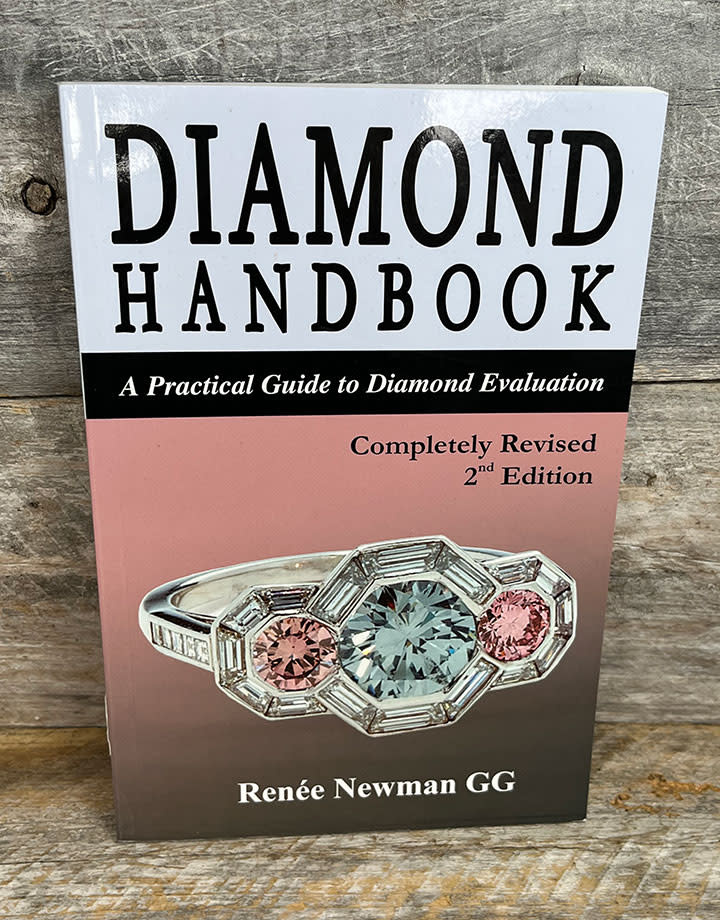BK5349 = Book - Diamond Handbook
| Article number: | BK5349 |
| Availability: | In stock |
Diamond Handbook: A Practical Guide to Diamond Evaluation By Renee Newman GG
The Diamond Handbook, 2nd edition is an up-to-date, full-color guide to evaluating and identifying diamonds, which is aimed at trade professionals, gemology students, serious diamond buyers, and people who want more diamond evaluation information than they can get on the Internet.
Besides providing in-depth information on diamond grading, it compares the new cut grading systems and diamond light performance reports of various gem laboratories. It also discusses and illustrates new diamond treatments and lab-grown diamonds.
An entire chapter is devoted to the recutting of diamonds, and another chapter covers the history of diamond cuts and illustrates antique and estate diamond jewelry styles. The first chapter gives a brief overview of diamond formation, sources, diamond properties, lighting and diamond examination techniques.
Chapters on fancy-colored diamonds, fluorescence, branded diamonds and diamond grading reports are also included.
The Diamond Handbook has a glossary, bibliography, index.
320 high-quality photos (207 in full color) and many informative tables, charts and diagrams.
As stated in a review of the first edition of the Diamond Handbook by the Journal of Gemmology: "The Diamond Handbook is a must for anyone buying, testing or valuing a polished diamond and for students in many fields.
"TABLE OF CONTENTS- Acknowledgments, Preface
Chapter 1: Basic Facts About Diamonds
What is a Diamond?
How are Diamonds Formed?
Where are Diamonds Found?
A closer Look at Diamond's Remarkable Properties
What Type of Magnification is Used to View Diamonds
Which Type of Lighting is Best for Viewing Diamonds
Other Tips on Viewing Diamonds
Chapter 2: Diamond Price Factors
Why the 4 C's is No Longer an Adequate Pricing System
Price Factors Explained
Chapter 3: Judging the Cut of Fancy Shapes, Judging Cut Quality
Bow Ties and Other Dark Patterns, Windows, Fisheyes, Excess Diamond Weight
Chapter 4: Judging Cut (Round Brilliants), Pavilion, Crown, Table, Girdle, Culet, Star Facet, Length %, Lower Girdle Facet %, Symmetry, Polish, "Ideal-Cut Diamonds, GIA & AGS Cut, Grading Factors Compared
Chapter 5: Judging Light Performance, Methods for Judging Light Performance, Gem Labs That Assess Light Performance, Tips on Evaluating Light Performance Visually
Chapter 6: A Closer Look at Clarity, Clarity Grades, Diamond Clarity Examples
Chapter 7: Fluorescence, Diamond Fluorescence, What Causes Diamond Fluorescence? Is Ultraviolet Lighting the Same as Fluorescence Lighting? Are Fluorescence Diamond Undesirable? My Advice Regarding Diamond Fluorescence
Chapter 8: Synthetic Diamonds, What are Synthetic Diamonds? How Does Growing Diamonds Differ From Culturing Pearls? Detecting Synthetic Diamonds, Diamond Types
Chapter 9: Diamond Treatments, Methods for Changing Color, Methods for Improving Clarity
Chapter 10: Judging Fancy Colored Diamonds, Evaluating fancy Colored Diamonds, Fancy Colored Diamond Rarity
Chapter 11: Antique Cuts & Jewelry, The History of Diamond Cuts, Pricing Antique Diamonds, Period Jewelry (European & American), Jewelry Periods
Chapter 12: Recutting Diamonds, How Do Cutters Modify Diamond Color?Getting Your Diamond(s) Recut
Chapter 13: Branded Diamonds
Chapter 14: Diamond Grading Reports, Mini-certs, How Reproducible and Lab Grades? Addresses of Some Diamond Grading Labs, Glossary, Chemical, Physical & Optical Characteristics of Diamonds, Bibliography, Index
Soft cover - 186pg.










